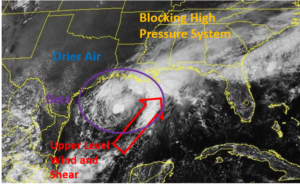A Tropical Storm Watch was issued for Bermuda on Thursday. At 8:00 p.m. EDT on Thursday the center of a nontropical low pressure system designated as Invest 90L was located at latitude 34.9°N and longitude 55.0°W which put it about 635 miles (1010 km) east-northeast of Bermuda. Invest 90L was moving toward the north-northwest at 13 m.p.h. (20 km/h). The maximum sustained wind speed was 60 m.p.h. (95 km/h) and there were wind gusts to 75 m.p.h. (120 km/h). The minimum surface pressure was 1004 mb.
A non-tropical low pressure system east-northeast of Bermuda prompted the Bermuda Weather Service to issue a Tropical Storm Watch. The low pressure system exhibited a non-tropical structure on Thursday night. There were bands of showers and thunderstorms revolving around the center of the low pressure system. However, there were not any thunderstorms near the center of the low. The strongest winds were occurring in the outer part of the circulation around the low. The low pressure system may have also had a cold core in the upper levels.
The surface portion of the low pressure system was rotating counterclockwise around an upper level low. The upper level low was forecast to steer the surface low toward the west on Friday. If the surface low moves westward, it will move over warmer Sea Surface Temperatures. The low pressure system could extract more energy from the Atlantic Ocean and thunderstorms could form near the center of circulation. The structure of the low pressure system could make a transition to a subtropical or a tropical storm. The National Hurricane Center indicated that the probability was 80% that a subtropical or a tropical storm could form during the next 48 hours.

